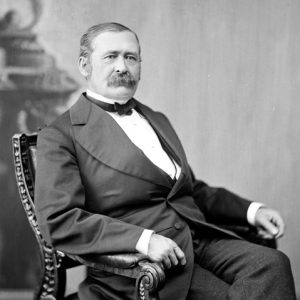calsfoundation@cals.org
John Milton Thayer (1820–1906)
John Milton Thayer was a lawyer and politician. During the Civil War, he was a major general in the Union army who served extensively in Arkansas. A native of Massachusetts, Thayer is most associated with Nebraska, where he served as both a senator and governor and commanded troops from that state during the war.
Thayer was born in Bellingham, Massachusetts, on January 24, 1820; he was the youngest of nine children. Thayer’s parents, Captain Elias Thayer and Ruthe Staples Thayer, owned a farm. Thayer worked as a school teacher before entering Brown University, from which he graduated in 1841. He married Mary Torrey Allen in 1842; they had six children.
Joining the bar in Massachusetts the same year he graduated from Brown, Thayer practiced in Worcester, Massachusetts, until 1854. He also participated in the local militia company, eventually serving as a lieutenant. In the spring of 1854, Thayer ventured to Nebraska to scout for land. His family followed him that autumn, and they purchased land for a farm. Thayer was also admitted to the bar in Nebraska in 1855.
Thayer continued his military service in his new state of Nebraska, where he was commissioned as the first brigadier general of the territorial militia. In this role, Thayer was tasked with leading expeditions against Pawnee Indians in 1855 and 1859.
In 1860, Thayer served as a delegate at the State Constitutional Convention and served in the territorial assembly the same year.
With the outbreak of the Civil War in 1861, Thayer was selected as the colonel of the newly formed First Nebraska Infantry Regiment. The Nebraskans served in Missouri and were transferred to Tennessee, where Thayer commanded a brigade at the Battles of Fort Donelson and Shiloh. Thayer continued to lead the unit during the campaign to take Corinth, Mississippi, and was promoted to the rank of brigadier general of volunteers on October 4, 1862. The U.S. Senate failed to act on the nomination, however, and it expired on March 4, 1863. He was quickly re-nominated and was confirmed on March 13.
Meanwhile, Thayer led his brigade at the Battle of Chickasaw Bayou and participated in his first action in Arkansas at the Battle of Arkansas Post. Returning to Mississippi, Thayer and his brigade participated in the Vicksburg Campaign as part of Major General Frederick Steele’s division.
Thayer was given command of the District of the Frontier on February 22, 1864, and made his headquarters at Fort Smith (Sebastian County). Less than one month later, Thayer was ordered by Steele, now commander of the Department of Arkansas, to join him at Arkadelphia (Clark County) on April 1. Part of the Red River Campaign, this push was called the Camden Expedition and was designed to help a Federal force on the Red River in Louisiana capture Shreveport, Louisiana.
Thayer and his command did not meet Steele and his men until several days after the April 1 deadline and were almost out of food by that time. Thayer’s command, known as the Frontier Division, participated in the remainder of the expedition, fighting at Prairie D’Ane, Poison Spring, and Jenkins’ Ferry.
After returning to Fort Smith, Thayer defended the post from attacks launched by Confederate forces in the Indian Territory during the summer of 1864. Thayer continued to serve at Fort Smith until February 27, 1865, when he was relieved of command and reassigned to St. Charles (Arkansas County), where he commanded that post until the end of the war.
At the conclusion of hostilities, Thayer was promoted to brevet major general, and he resigned his commission on July 19, 1865. He returned to Nebraska, where in 1867 he became one of the state’s first U.S. senators. In 1875, he was appointed governor of the Wyoming Territory, serving until 1878. He was elected governor of Nebraska in 1886 and 1888. He remained in office through 1892 by claiming that his successor was not a U.S. citizen; he was eventually removed from office by the U.S. Supreme Court. He died in Lincoln, Nebraska, on March 19, 1906, and is buried in Wyuka Cemetery.
For additional information:
Capace, Nancy. The Encyclopedia of Nebraska. St. Clair Shores, MI: Somerset Publishers, 1999.
Warner, Ezra. Generals in Blue. Baton Rouge: Louisiana State University Press, 1981.
David Sesser
Henderson State University
 Second Arkansas Infantry (US)
Second Arkansas Infantry (US) John Thayer
John Thayer 




Comments
No comments on this entry yet.